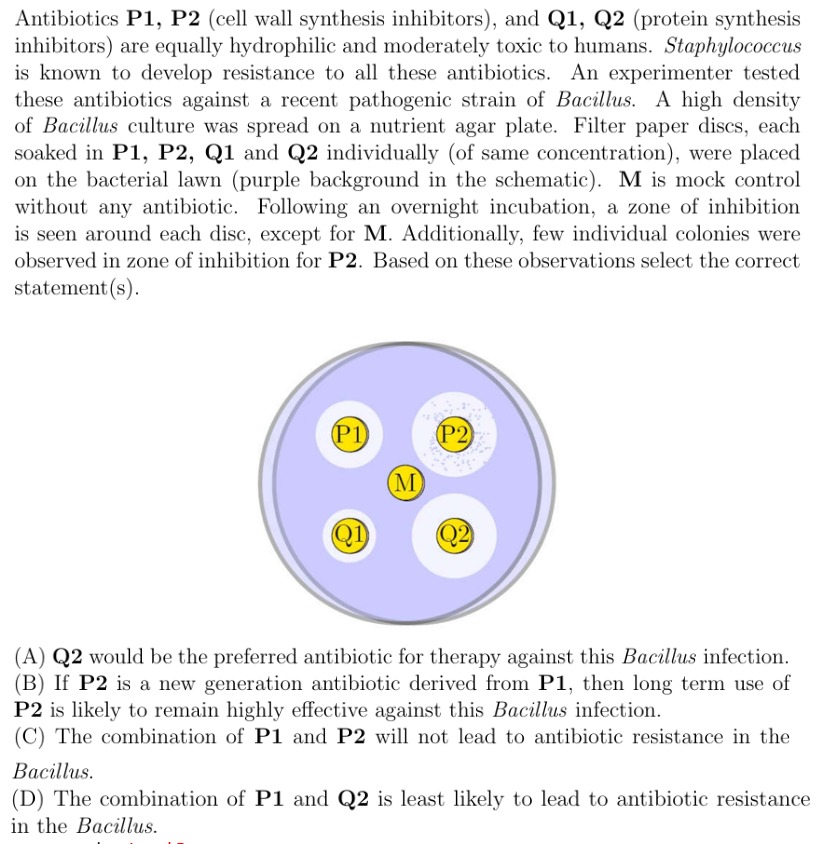Question
Question: Antibiotics **P1, P2** (cell wall synthesis inhibitors), and **Q1, Q2** (protein synthesis inhibitor...
Antibiotics P1, P2 (cell wall synthesis inhibitors), and Q1, Q2 (protein synthesis inhibitors) are equally hydrophilic and moderately toxic to humans. Staphylococcus is known to develop resistance to all these antibiotics. An experimenter tested these antibiotics against a recent pathogenic strain of Bacillus. A high density of Bacillus culture was spread on a nutrient agar plate. Filter paper discs, each soaked in P1, P2, Q1 and Q2 individually (of same concentration), were placed on the bacterial lawn (purple background in the schematic). M is mock control without any antibiotic. Following an overnight incubation, a zone of inhibition is seen around each disc, except for M. Additionally, few individual colonies were observed in zone of inhibition for P2. Based on these observations select the correct statement(s).

Q2 would be the preferred antibiotic for therapy against this Bacillus infection.
If P2 is a new generation antibiotic derived from P1, then long term use of P2 is likely to remain highly effective against this Bacillus infection.
The combination of P1 and P2 will not lead to antibiotic resistance in the Bacillus.
The combination of P1 and Q2 is least likely to lead to antibiotic resistance in the Bacillus.
A, D
Solution
The problem describes an experiment testing four antibiotics (P1, P2, Q1, Q2) against a pathogenic strain of Bacillus.
Key Information and Observations:
-
Antibiotic types: P1, P2 are cell wall synthesis inhibitors. Q1, Q2 are protein synthesis inhibitors.
-
General properties: All are equally hydrophilic and moderately toxic to humans.
-
Staphylococcus resistance: Staphylococcus is known to develop resistance to all these antibiotics. This highlights the general problem of antibiotic resistance.
-
Experiment results (Bacillus):
- All antibiotics (P1, P2, Q1, Q2) created a zone of inhibition, meaning they are effective against Bacillus.
- Crucial observation: Few individual colonies were observed within the zone of inhibition for P2. This indicates that some Bacillus cells in the population are already resistant to P2, or rapidly developed resistance to P2 during the incubation.
- Visually, the zone of inhibition for Q2 appears to be the largest and clearest among all antibiotics.
Evaluation of Statements:
(A) Q2 would be the preferred antibiotic for therapy against this Bacillus infection.
- The size of the zone of inhibition indicates the effectiveness of an antibiotic. A larger, clearer zone implies greater efficacy.
- From the schematic, Q2 has the largest and most uniform zone of inhibition, with no visible colonies within the zone.
- In contrast, P2 already shows signs of resistance (colonies within the zone). P1 and Q1 have smaller zones compared to Q2.
- Given that all antibiotics are equally hydrophilic and moderately toxic, efficacy is the primary criterion for preference. Therefore, Q2, showing the highest efficacy and no observed resistance, would be the preferred choice for initial therapy among the single antibiotics. This statement is correct.
(B) If P2 is a new generation antibiotic derived from P1, then long term use of P2 is likely to remain highly effective against this Bacillus infection.
- The experiment explicitly shows "few individual colonies were observed in zone of inhibition for P2." This is direct evidence that Bacillus has already developed resistance or contains pre-existing resistant strains to P2.
- Long-term use of an antibiotic to which resistance is already present will lead to the selection and proliferation of resistant strains, making the antibiotic less effective over time, not more. This statement is incorrect.
(C) The combination of P1 and P2 will not lead to antibiotic resistance in the Bacillus.
- P1 and P2 are both cell wall synthesis inhibitors, meaning they have similar mechanisms of action.
- Resistance to P2 is already observed. Combining two antibiotics from the same class, especially when resistance to one is already evident, is not an effective strategy to prevent resistance. Bacteria might develop cross-resistance or easily acquire resistance to both.
- Furthermore, stating that it "will not lead to antibiotic resistance" is an absolute claim that is generally false for any antibiotic strategy, as resistance is an evolutionary process. This statement is incorrect.
(D) The combination of P1 and Q2 is least likely to lead to antibiotic resistance in the Bacillus.
- P1 is a cell wall synthesis inhibitor, and Q2 is a protein synthesis inhibitor. These two antibiotics have distinct and independent mechanisms of action.
- A fundamental principle in antibiotic therapy to combat resistance is to use a combination of drugs that act on different targets or pathways. This makes it much harder for bacteria to develop resistance, as they would need to acquire multiple, independent resistance mechanisms simultaneously.
- Therefore, combining P1 and Q2 (different mechanisms) is indeed the strategy least likely to lead to the development of antibiotic resistance compared to monotherapy or combining drugs with similar mechanisms. This statement is correct.
Conclusion:
Based on the analysis, both statements (A) and (D) are correct.
